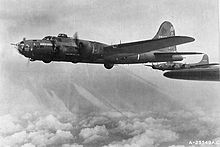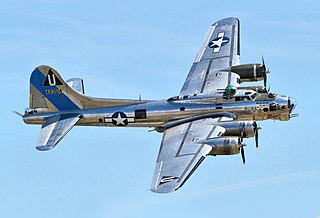
The Boeing B-17 Flying Fortress is a four-engined heavy bomber developed in the 1930s for the United States Army Air Corps (USAAC). Relatively fast and high-flying for a bomber of its era, the B-17 was used primarily in the European Theater of Operations and dropped more bombs than any other aircraft during World War II. It is the third-most produced bomber of all time, behind the four-engined Consolidated B-24 Liberator and the multirole, twin-engined Junkers Ju 88. It was also employed as a transport, antisubmarine aircraft, drone controller, and search-and-rescue aircraft.
German submarine U-571 was a Type VIIC U-boat built for the Kriegsmarine of Nazi Germany for service during World War II. U-571 conducted eleven war patrols, sinking five ships totalling 33,511 gross register tons (GRT), and damaging one other for 11,394 GRT. On 28 January 1944 she was attacked by an Australian-crewed Sunderland aircraft from No. 461 Squadron RAAF west of Ireland and was destroyed by depth charges. All hands were lost.

The Blohm & Voss BV 138Seedrache, but nicknamed Der Fliegende Holzschuh was a World War II German trimotor flying boat that served as the Luftwaffe's main seaborne long-range maritime patrol and naval reconnaissance aircraft.
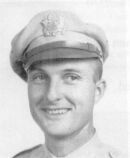
Leon Robert Vance Jr. was a Medal of Honor recipient who served in the United States Army Air Forces during World War II.

Royal Air Force Station Polebrook or more simply RAF Polebrook is a former Royal Air Force station located 3.5 miles (5.6 km) east-south-east of Oundle, at Polebrook, Northamptonshire, England. The airfield was built on Rothschild estate land starting in August 1940.

The 91st Bomb Group (Heavy) was an air combat unit of the United States Army Air Forces during the Second World War. Classified as a heavy bombardment group, the 91st operated B-17 Flying Fortress aircraft and was known unofficially as "The Ragged Irregulars" or as "Wray's Ragged Irregulars", after the commander who took the group to England. During its service in World War II the unit consisted of the 322nd, 323rd, 324th, and 401st Bomb Squadrons. The 91st Bomb Group is most noted as the unit in which the bomber Memphis Belle flew, and for having suffered the greatest number of losses of any heavy bomb group in World War II.

Royal Air Force Bassingbourn or more simply RAF Bassingbourn is a former Royal Air Force station located in Cambridgeshire approximately 3 mi (5 km) north of Royston, Hertfordshire and 11 mi (18 km) south west of Cambridge, Cambridgeshire, England.

Nine-O-Nine was a Boeing B-17G-30-BO Flying Fortress heavy bomber, of the 323d Bombardment Squadron, 91st Bombardment Group, that completed 140 combat missions during World War II, believed to be the Eighth Air Force record for most missions, without loss to the crews that flew her. A different B-17G, painted to mimic the Nine-O-Nine, crashed at Bradley International Airport in Windsor Locks, Connecticut, in October 2019.

Shoo Shoo Shoo Baby, originally Shoo Shoo Baby, is a Boeing B-17 Flying Fortress in World War II, preserved and currently in storage at the National Museum of the United States Air Force, awaiting transfer to the Smithsonian's National Air and Space Museum. A B-17G-35-BO, serial number 42-32076, and manufactured by Boeing, it was named by her crew for a song of the same name made popular by The Andrews Sisters, the favorite song of its crew chief T/Sgt. Hank Cordes. Photographs of the bomber indicate that a third "Shoo" was added to the name at some point in May 1944 when the original aircraft commander completed his tour of duty and was replaced by another pilot.

Pan Am Flight 6 was a round-the-world airline flight that ditched in the Pacific Ocean on October 16, 1956, after two of its four engines failed. Flight 6 left Philadelphia on October 12 as a DC-6B and flew eastward to Europe and Asia on a multi-stop trip. On the evening of October 15 the flight left Honolulu on a Boeing 377 Stratocruiser Clipper named Sovereign Of The Skies. The accident was the basis for the 1958 film Crash Landing.
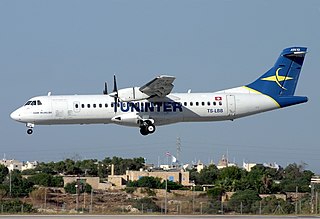
Tuninter Flight 1153 (UG1153/TUX1153) was a Tuninter Airlines international flight from Bari International Airport in Bari, Italy, to Djerba-Zarzis Airport in Djerba, Tunisia. On 6 August 2005, the Tuninter ATR 72 ditched into the Mediterranean Sea about 18 miles (29 km) from the city of Palermo. Sixteen of the 39 people on board died. The accident resulted from fuel exhaustion due to the installation of fuel quantity indicators designed for the ATR 42 in the larger ATR 72. It was also Tuninter's first fatal accident in the 14-year history of the company.
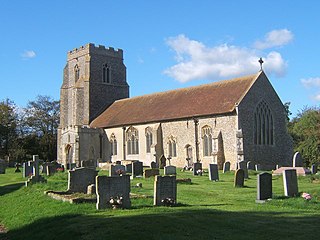
Tannington is a village and civil parish in the Mid Suffolk district of Suffolk in eastern England. Located around ten miles south-east of Diss, in 2005 its population was 110. At the 2011 Census the population had fallen below 100, and not therefore being maintained on this site was included in the civil parish of Brundish.

Dumbo was the code name used by the United States Navy during the 1940s and 1950s to signify search and rescue missions, conducted in conjunction with military operations, by long-range aircraft flying over the ocean. The purpose of Dumbo missions was to rescue downed American aviators as well as seamen in distress. Dumbo aircraft were originally land-based heavy bomber aircraft converted to carry an airborne lifeboat to be dropped in the water near survivors. The name "Dumbo" came from Walt Disney's flying elephant, the main character of the animated film Dumbo, appearing in October 1941.

Pan Am Flight 526A, a Douglas DC-4, took off from San Juan-Isla Grande Airport, Puerto Rico, at 12:11 PM AST on April 11, 1952 on a flight to Idlewild International Airport, New York City with 64 passengers and five crew members on board. Due to inadequate maintenance, engine no. 3 failed after takeoff, followed shortly by engine no. 4. Nine minutes after takeoff, the aircraft ditched in rough seas 11.3 miles NW of San Juan Airport, broke apart and sank after three minutes. Panicking passengers refused to leave the sinking wreck. 52 passengers were killed, and 17 passengers and crew members were rescued by the USCG. After this accident it was recommended to implement pre-flight safety demonstrations for over-water flights.
This is a partial list of accidents and incidents involving the Boeing-designed B-17 Flying Fortress. Combat losses are not included except for a very few cases denoted by singular circumstances. A few documented drone attrition cases are also included.
German submarine U-417 was a Type VIIC U-boat of Nazi Germany's Kriegsmarine during World War II.

VPB-103 was a Patrol Bombing Squadron of the U.S. Navy. The squadron was established as Bombing Squadron 103 (VB-103) on 15 March 1943, redesignated as Patrol Bombing Squadron 103 (VPB-103) on 1 October 1944 and disestablished on 31 August 1945.
VP-27 was a Patrol Squadron of the U.S. Navy. The squadron was established as Patrol Squadron 83 (VP-83) on 15 September 1941, redesignated Bombing Squadron 107 (VB-107) on 15 May 1943, redesignated Patrol Bombing Squadron 107 (VPB-107) on 1 October 1944, redesignated Patrol Squadron 107 (VP-107) on 15 May 1946, redesignated Heavy Patrol Squadron (Landplane) 7 (VP-HL-7) on 15 November 1946, redesignated Patrol Squadron 27 (VP-27) on 1 September 1948 and disestablished on 11 January 1950.
I-37, originally numbered I-49, was a Japanese Type B1 submarine in service with the Imperial Japanese Navy during World War II. Commissioned in 1943, she made three war patrols, all in the Indian Ocean, during the last of which her crew committed war crimes by massacring the survivors of the merchant ships she sank. Subsequently, converted into a kaiten manned suicide attack torpedo carrier, she was sunk during her first kaiten mission in 1944.

